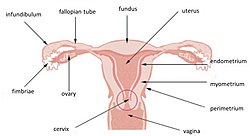Fimbria (female reproductive system)
| Fimbriae of uterine tube | |
|---|---|

Uterus and uterine tubes
|
|

1: Ovary
2: Medial surface 3: Lateral surface 4: Free border 5: Mesovarial margin 6: Tubal extremity 7: Uterine extremity 8: Oviduct (fallopian tube) 9: Opening of fallopian tube 10: Infundibulum of fallopian tube 11: Fimbriae of fallopian tube 12: Ovarian fimbria 13: Ampulla of fallopian tube 14: Isthmus of fallopian tube 15: Uterine part of fallopian tube 16: Uterine opening of fallopian tube |
|
| Details | |
| Identifiers | |
| Latin | fimbriae tubae uterinae |
| Dorlands /Elsevier |
f_07/14185583 |
| TA | A09.1.02.004 |
| FMA | 18308 |
|
Anatomical terminology
[]
|
|
In the female reproductive system, the fimbria (plural, fimbriae) is a fringe of tissue around the ostium of the Fallopian tube, in the direction of the ovary.
An ovary is not directly connected to its adjacent Fallopian tube. When ovulation is about to occur, the sex hormones activate the fimbriae, causing it to swell with blood and hit the ovary in a gentle, sweeping motion. An oocyte is released from the ovary into the peritoneal cavity and the cilia of the fimbriae sweep the ovum into the Fallopian tube.
Of all fimbriae, one fimbria is long enough to reach the ovary. It is called fimbria ovarica.
Uterus and right broad ligament, seen from behind.
...
Wikipedia
